I can’t decide whether to begin this week with a sweet treat, the garden, or something cleansing, refreshing and nourishing - a cup of which will make you just go ahhhh! But given this was the very first image on my roll post last week’s instalment, I’ll start with the naughty! Something about it sums up the season - all citrusy and scented, with sprigs and stems nestled safe inside behind the glass, as we hurtle between days so blissful and bucolic, so sublimely perfect, that all one can do is keep saying isn’t it glorious? Magic? Aren’t we lucky? And the next that are blustery, nerves-on-edge kind of days, when all one can do is anticipate the next likely disaster. A sweet treat to look forward to at tea time can take the edge off…as windfall lies strewn all over, a hefty branch lies here and there (one just took out some of the double row of Acanthus mollis that are budding beautifully on the Dairy path, as well as an old ceramic bowl I’ve had sitting outside for years…ho hum). Some days, it’s just best to stay inside. All of it is to be expected of course - August has always jumped about in temperature and craziness…for as long as I can remember. Like all things…it will pass.
The Flourless Lemon Cake (above) is a take on the Orange one. Funny…I’d never considered swapping out the oranges for lemons ‘til last year! For a good Lemon Cake, I’ve long made one called Joyce’s Lemon Cake from Damien Pignolet’s lovely recipe book ‘French’. It’s delicious, very plain and to be honest, absolutely perfect. Though for a lemon cake, it doesn’t use so many lemons! Last year I thought to see what would happen if I substituted lemons for oranges in that cake that everyone seems to love (and the one most peeps tell me they make from those recipes listed in The House & Garden at Glenmore - especially peeps who tell me they didn’t think they could make a cake!) and the result was simply delish. It sums up the season as we truly are moving on from the oranges now - sadly. Although Valencias are on their way in as the Navels are all but gobbled up (I probably have enough for another couple of weeks), it’s the Lisbon lemon that is truly heaving with fruit, suggesting this is the perfect cake du jour. As I want to give you another recipe this week (a healthy one!) here is the link to the recipe index, so you can find the recipe for the Flourless Orange Cake easily (cakes are at the top of the list). Do exactly as that recipe says, but replace the oranges with lemons and zest away!
Of course I didn’t make the cake just for us. I made it for Saturday’s beautiful Lunar Cultivation Workshop with Alchemilla’s Phoebe West…and what a truly delightful, insightful, inspiring day we had. A small group, each invested in the gentle discussion as we chatted at length, in the round…on the gravitational pull and release, the inhaling and exhaling of the earth in tandem with the rhythmic cycle of the moon through the constellations; the energy we can generate ‘twixt the earth and the plants we nurture if we pay attention to the cycle, and biodynamic principles.
These are all things I’ve long played with, though real life commitments tend to prevent me from complete immersion. I’ve long been aware the effect the cycle of the moon has on me personally (I am a Cancerian afterall!) and so I don’t need much persuasion to believe the moon effects more than the oceans’ tides.
Phoebe’s latest Almanac is a comprehensive publication, with simple explanation and definition across holistic and biodynamic cultivation, permaculture, regenerative and first nations agriculture; the phases of the moon, lunar and cosmic terminology, alongside charts and tables suggesting the best planting windows to sow, to nurture, or down tools, across leaf, flower, seed and root crops.
One doesn’t need to be a scientist or mystic to comprehend it. And even if one doesn’t quite grasp it all at once, Phoebe’s explanations are so concise that her Almanac is a reference to which we can return time and again ‘til we do…’til understanding the definitions and synchronicity are in our very make up.
A couple of our participants were aware their grandparents had farmed or gardened using this ancient knowledge and felt innately that it was time to bring this rhythm back into their own lives. I was delighted we had one male participant, whose contribution to the discussion was invaluable. I know we’re all already putting Phoebe’s Almanac to work! I know she’s running low on stock - as it’s an annual handbook (a bit like a diary but more fun!) if you can get hold of one, it will see you through ‘til June next year. (She did leave me with a couple here). Even if you’re not growing, it makes for captivating reading…a little book that reveres people, the environment, the earth and the atmosphere. As always, there is so much to learn, to practice, and to comprehend. And…how delighted I was (as were our participants) to meet Phoebe in person!
You’ll recall I was in such a rush at the end of last week’s post as Phoebe was due to arrive and I did so want to welcome and settle her in. I’d already made the Lemon Cake and prepped the Spring Greens Pie (Belinda Jeffery 10 year anniversary edition Mix & Bake) and had a big batch of Scented Veg Stock simmering away on the cooktop.
Like the lemon cake, this is the clear soup I begin making in regular batches at this time of year. There is something wonderfully cleansing and nourishing about a little cup, that goes so well with the season - it’s just what we need on these crazy days of ricocheting temperature and is so very easy to make. It’s another recipe of Anastasia’s (she of the Chestnut Flour Cake - I know I told you all about Anastasia in the post that contained that recipe and if you follow the link to the recipe index and to that cake, you can read it again!).
Everyone seems to love a little cup of this and whenever I bring it out everyone wants the recipe. So here it is:
Scented Vegetable Stock
Ingredients
2 onions peeled and diced
3 large carrots chopped
2 large sticks celery chopped
1 tablespoon coriander seed
3 star anise
1/2 tablespoon fennel seed
1/2 teaspoon black peppercorns
1 tomato quartered*
5 cups water but with all of it, no need to be too precise! I fill a very big saucepan with water!
*I’m very aware tomatoes are not in season! As I freeze so many of those San Marzanos after oven baking them, I throw in a few of those halves.
Method
Heat a few tablespoons olive oil over a medium heat
Add onion, celery, carrot, coriander seed, fennel seed, star anise and black peppercorns
Sweat these aromatics until the vegetables are soft and golden
Add the water and tomato and bring to a gentle simmer
Cook gently for about an hour or until the stock tastes rich and full
Strain and discard the solids
That’s the basic recipe…which is more than good enough on its own! There are various things though, that you might like to add when it comes to serving and if so, a little forward planning will help you intensify the flavours you might choose to focus on. Over the years I’ve added some of these:
Finely slice a fennel bulb and toss gently in olive oil and a squeeze of lemon juice in a pan for just a minute or two prior to serving: add a slice or slither to bowl or cup (I often serve this in a cup and so slice or chop to suit the size of the vessel I intend to use). If I were to do this, I’d add extra fennel stalks and the outer pieces of the bulb I might otherwise discard to the basic recipe during the simmering.
Chop some sugar snap peas into little segments and/or pod some shelling peas. Quickly blanche and toss peas in a little olive oil just a minute before serving. (If I were to do this I’d add pea pods to the basic recipe during the simmering. Top with a pea flower! (They are edible and delicious - they taste of pure pea)
Finely dice stems of colourful rainbow chard - try to use a stem of each colour as they retain their vibrancy - so one crimson, one coral, one red, one yellow…and toss in a little olive oil just prior to serving. They’ll float to the surface and look very pretty indeed! (If I were to do this, I’d add the bulk of those stems to the basic recipe during the simmering.
Add a dollop of pistou - whether parsley, fennel or coriander and give it a swirl. Maybe add a calendula or nasturtium petal or two or a borage flower
In this way, you are truly eating the season! There are so many other things you could consider adding but…as I’m inclined to do at this time of year…just keep a bowl in the fridge and warm enough for a cup or mug and sip at any time of the day. Now that will put a spring in your step!
The Pantry is almost fully festooned in Jasmine flowers now and the perfume is divine! Last week, the swathe was mostly in pink bud with a cascade or two of lovely perfumed flowers - the moment at which I love it best for it’s all anticipation of what lies ahead…which is this! Tomorrow it will most probably be too much and anymore wind it will all be over too fast! I adore Jasminum officinale. I know many peeps don’t, but I do love that perfume and even had threads of it running through my wedding bouquet. It’s reminiscent of my childhood (my parents grew one) and I remember how excited I was on those first winter ‘picnic’ day-visits to Glenmore( when we couldn’t yet stay) to find one enormous mound over the old dunnies. I’d take armfuls back to the city with me, strewing it all around our little house! Although that mound got swept away in the restoration project, I wasted no time in planting another. It took awhile to persuade it to smother the old ‘separating shed’ that was sited right next to the old Dairy…and is the only original part of that complex that we could rescue. Whilst I’m not a fan of the bricks, it’s a darling little building that almost stands alone and these days we call it the Pantry: it serves as a kitchen for all the workshops and events and with its black and white chequerboard floor, and the old door opened and pinned back to the wall, it fills with early morning sun through the flyscreen in one direction; and a view to Rowan’s cows on the hill through the opposite window. It’s a joy to work in throughout any long cooking and washing up day and at this time of year, the added bonus is the perfume drifting in from all around.
On Sunday, I really got to work in the Field…what a mess it was! As I explained a few weeks back when I was working in the Borders, I felt they were at their lowest ebb of the year, and that’s exactly how I felt about the Field. I know I also said I wished I could go faster…wishing for a solid week to race through every single winter job! But instead I simply must work around the garden in some semblance of order, and the Field can wait the longest, even if I’m itching to get to it!.
On Sunday I managed to get the two rows of ‘repeat flowering’ roses pruned…hard. It’s in winter that they require the most severe cut back and I was quite brutal - secateurs, saw and new toy (well, last year’s new toy!) a mini-hand-held electric chain saw which is a wonder tool! I don’t use it for many cuts, but there are always some that are such hard work with the manual saw!
Then on Monday (cos I’m running out of time now and have lost two weekends to workshops) I worked with Thalia to get those two beds underway with their soil prep and whilst she began loading barrows of compost, I got the ‘sudden impact for roses’ spread all around (watering well before and after) and lightly pruned the two rows of ‘spring flowering’ roses. At this time of year, they’re not such hard work as they have their main pruning after they flower. But even so, there were some dead branches to remove as well as plentiful criss-crossing branches that are no good to each other - especially in the wind. So whilst I say a light pruning, that doesn’t mean there wasn’t still rather a lot of it!
In the intervening days, I’ve had a ‘working week’ and Thalia has made good progress with adding compost. She’s not quite yet finished! And while I almost can’t look at the rows of exposed compost, we cannot add sugar cane mulch ‘til the winds subside as it will simply blow away! On that score, the last few years I’ve used hemp mulch on the rows but as I’ve mentioned before I can get it no longer, so this year it will be sugar cane. To be honest, down in the Field, I’d rather use the ‘forest fines’ we’re using in the ornamental garden to mulch the rows, but the reason I’m not is that we also use those ‘forest fines’ on the Field paths, where it seems right to do so. Their colour is in harmony with the eucalypt vegetation beyond, they keep the framework of the Field in place, the earth between the rows in tact - I didn’t want any kind of hard standing and so as I feel there must be some differentiation between path and rows, I opt for something of a different colour, nature and makeup for the rows themselves. Oh but how I feel I’ve not finished the job and am doing the soil a disservice! I hope I can report next week that I’ve been able to cover that precious compost and protect the micro-organisms and ensure I’m doing the right thing by the soil’s needs.
I might even get around to filling you in about the Field properly next week…I feel like it’s almost time and rather like the gardening of it, I haven’t yet had a chance to really tell you about it! In tandem with the tale of the Field of Flowers will come the story of the Botanical Waters. Their stories belong together, are inseparable; and once I have the Field back in order from a ‘gardening’ perspective, it will be time to move onto the purpose of its existence…to capture the essence of its plants in a bottle!

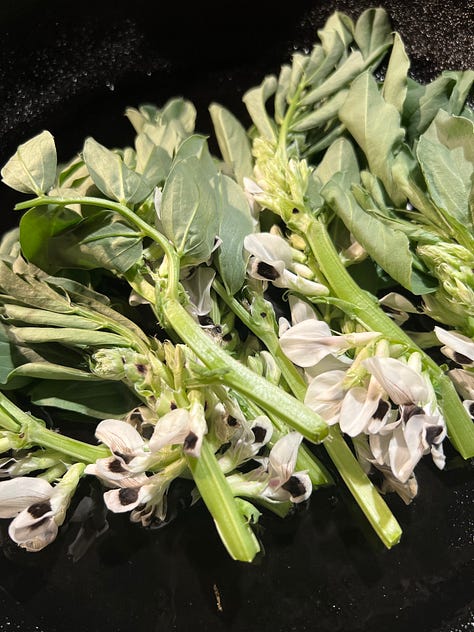
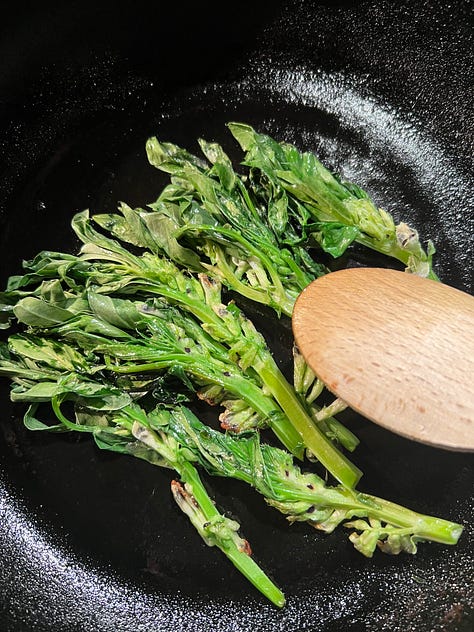
Do you recall at the end of last week’s post that I made mention of the fact that I honestly think my previous conception of broad bean tips being a treat, has grown to a belief that they are a significant staple in our sprinter diet? This year, the crop has been healthy beyond belief (hope I don’t jinx it!). If you backtrack through my posts since crop rotation began, to when I first built the annual structure with Thalia, prepared the soil, sowed the seed, waited with baited breath for the seeds to germinate and grow up, up, up through the three horizontal ‘keepers’ to protect them from these anticipated horrible winds, you’ll know just how much hope I have invested in these stalwarts of the legume family. I always do…each and every year.
But somehow this year, those plants (so far anyway) are more dense, prolific and healthy. I mentioned how the afternoon air is filled with their flowery scent. Warmed all day in the sun, it’s as if there’s one huge exhale of perfume in the still, early evening light as I pick for dinner (on a calm day anyway, and I hope that description portrays the atmosphere in the kitchen garden at this particular moment in the growing year!).
As a result, I’ve seemingly picked a vast number of ‘tips’. Now the leading stems are all up and through the highest bar of their structure, it’s imperative to remove the tips in order to further strengthen the plants, which then put on more basal growth. At the end of the day, I’m really growing for the beans that will soon start to appear, but with extra and healthy basal growth, I have more and more tips to pick and over these last couple of weeks they’ve truly become an integral part of our diet.
When I popped a pic onto instagram this week, someone asked how I cook them, so although the pics aren’t imaginitive, you will get the idea of how simple they are to prepare! Of course you can eat them raw, right there in the garden, but also…
Wilted Broad Bean Tips
Take the top 3 inches / 8cm ‘ish off the stem (as long as its pushed up through its last keeper rail!)
Remove the lower leaves but leave a couple of the tighter ones at the very tippy top
Heat a good splash of olive oil in a pan (add a little sea salt and a twist of black pepper if you like)
Toss in the tips and gently cook, tossing about with a wooden spoon, just ‘til they wilt
Good enough to eat on their own (oh dear…mine rarely get to the plate!) they are terrific either in or atop a simple omelette or a risotto (I popped a couple to top each mound of pumpkin risotto last week when Phoebe came to stay). Don’t worry too much about what they go with, or how many you have - even one is divine, but I’ve been stirring them into pasta and using them for all manner of last minute flourishes. Whilst I know they are delicious battered and fried, I just don’t cook that way, but by all means do! Just make the most of them while they’re here. I do hope you’re beginning to understand just how valuable having a crop of broad beans growing in the kitchen garden really is!
Given my newly restored interest in the rhythm of the lunar cycle and following last weekend’s discussion, I’ve been hyper aware that in this fourth week as the moon wanes and the earth inhales, it’s the optimum time for planting root vegetables.
Planting out the seed potatoes I ordered months ago (and that have been happily sitting in the cellar and beginning to ‘chit’ ie sprout shoots) has been on my mind and prompted by proof in the Almanac that this is the week, I brought out the box!
I couldn’t get hold of all the varieties I wanted this year (it would seem potato growing has become more popular and although I thought I was ordering in plenty of time, already I couldn’t get some favourites). So I doubled up on my all-time favourites: Nicola, Dutch Cream and…last but far from least, in fact my very favourite of all, King Edward!
Have I mentioned the time I had an event here when the topic was the Duchess of Windsor’s Jewels? Goodness it’s so long ago, when Sydney jeweller Robb Gardner who had researched the topic at length gave a quite glorious presentation. One of my repeat participants had heard him give the talk in Sydney and said I really must invite him, so I did! I mean why not? If anyone can link jewellery to fruit and veg, gardens and growing and food on a plate, then I guess perhaps it’s me!
It was early autumn and my potatoes were still going strong. I recall having so much fun with the menu, making a bejewelled version of Coronation Chicken - all decked out in grapes and pomegranate seeds, and to accompany that colourful platter, a huge bowl of beautiful pink-blotched and streaked King Edward and purple Sapphire potatoes! I just couldn’t help myself! We enjoyed a jewel-bedecked lunch to bolster a sparkly and historically fascinating presentation!
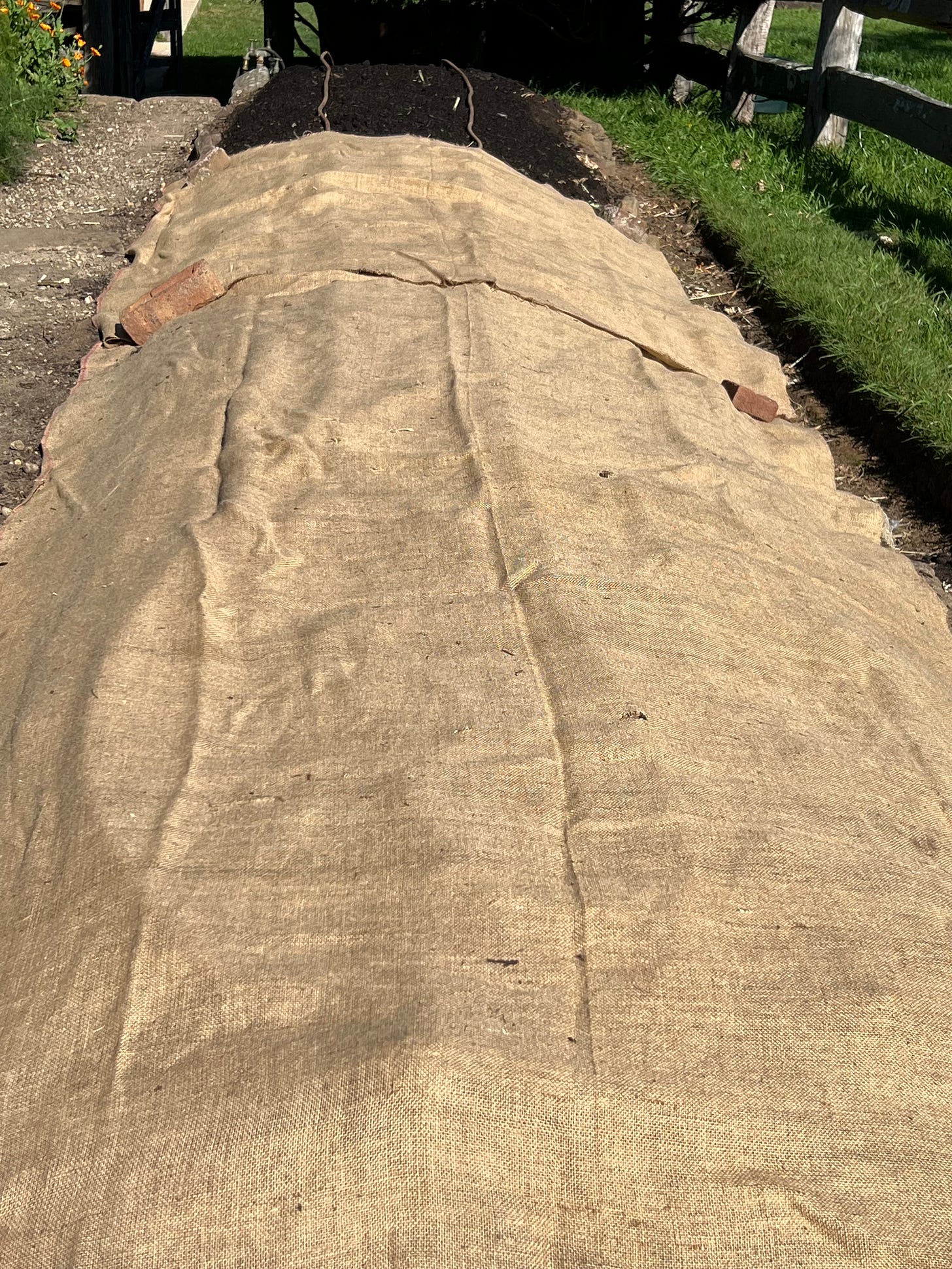
But back to the garden and what perhaps signifies the beginning of the next crop rotation - the seed potatoes went into the ground at a depth of about 20cm (as deep as we can get them in this bed) and were then well covered with a thick, thick layer of compost. Same story as the Field…I can’t put sugar cane mulch out yet because of the wind, so I’ve temporarily covered the mulch with hessian (I’ve mentioned before that once a hessian cloth has done its duty on the lunch tables, its next mission is to go to work in the garden - these ones were badly splashed with olive oil and so they’ve been moved on to their next job). Covering the mulch makes me feel so much better - hessian is an ideal substitute for mulch as it allows the soil to breathe, whilst protecting it from the elements. The micro-organisms can get to work and the potatoes are well in the dark.
Before I leave this topic of sowing potatoes…whilst its common practice to dig a trench, sow and backfill as the green stems shoot and grow; long ago I discovered this didn’t work in our climate and it seemed a sure way to kill them here. I know I’m not alone. For many years now, I’ve just done the whole potato sowing in one go: sow, backfill, add a good layer of compost and finish with a thick layer of mulch. We seemingly get a very good annual crop so if you’re struggling…maybe try this way too.
With everything budding and swelling and popping all over, it seems there’s something new at which to gasp each time I step off the verandah! I just noticed a couple of fully clothed wisteria flowers and I swear their buds were no longer than my thumb this time yesterday! With deciduous tree branches at leaf bud one minute, and a fine green tinge the next; early blossom is quickly being replaced with delicate new leaves. In the near distance, the waters of the dam sparkle as the wind whips the surface to a frenzy - the effect of the whole is quite dazzling.
Despite my best efforts, I feel like I’m still leaving out a whole lot of goings-on here each week! Do be sure to read to the end as I sometimes pop in some extra nonsense in the wrap of seasonal produce and gardening tasks below signing off!
This week I have a little bug-bear though and I’m going to mention it because it’s part of the reason I began running kitchen gardening workshops here in the first place (to help peeps understand what truly is in season, aside from how to grow): Not once, but three times this week I’ve noticed peeps mention they’re cooking with zucchinis (all of them peeps I love!). If they were living in Italy right now, I wouldn’t raise an eyebrow, but in Sydney…if grown in normal conditions, it’s not yet quite even time to sow their seed! So if you’re cooking with them, they either come with many miles attached, or they’ve been refrigerated for a long time or they’ve been grown artificially. (Or maybe they’re growing in a super protected magical micro-climate…maybe it’s not impossible but as a crop to sell in the shops, improbable!). Just saying! There is a multitude of produce right now that is in season…so why not make the most of it?
Keep safe everyone…the winds are not kind. ‘Til next week,
sending warmest wishes
Mickey x
Productive garden notes:
Eating from the garden:
Navel oranges, mandarins (going), Lisbon lemons, rhubarb; Jerusalem artichokes (going), parsnip (Clemmie has left some!), celeriac (new) pumpkins (going). Leaves of all kinds - spinach, kale - cavolo nero (Red Russian is still growing on - I’ll skip including it next week cos honestly…I think I grow it for its beauty and we rarely seem to actually eat it - by the time its ready I no longer feel like eating kale!), leeks, lettuce, radicchio, rocket, red elk mustard leaf, warrigal greens. Cauliflower (one to go), broccoli, fennel bulbs, radish. Peas, broad bean tips and…I pulled the Savoy Cabbage! It will keep us going for a couple of weeks! Fennel fronds, parsley, mint, rosemary, thyme, chives, coriander, nasturtium and calendula petals, borage flowers.
I also keep meaning to say…we’re eating the dried beans saved from the summer Speckled Cranberry Borlotti Bean crop - a spectacular staple!
Going / gone: mandarins, Jerusalem artichokes, pumpkins
Seed saving: none (though some rocket seed isn’t far off)
Sowing: lettuce and rocket are on my sowing wishlist - maybe this Sunday! I’ve staked the little tomato seedlings with fine wooden skewers and each day I turn their tray to face the opposite direction - they are inclined to grow towards the sun so to encourage strong, straight stems, it’s a good idea to keep turning them.
Planting: potatoes
Ornamental garden notes:
Picking for the house: Solandra trumpets, Jasmine, Clivea and blossom of Manchurian Pear - I picked some long branches for last Saturday’s workshop where those clear flowers on bare stems seemed just right for our lunar topic. They’re good in a vase - I brought them into the kitchen and they’re still here on the bench where I’ve enjoyed them all week (though inside, their perfume is quite dense - heather honey verging on diesel!).
Perfumes and aromas: Jasmine, Solandra, Daphne, Ceanothus, Manchurian Pear blossom (hope I haven’t put you off!), Broad Bean blossom and that of ripe oranges and lemons as they bask in the warmth of their bowls on the kitchen bench.
Pruning and other: Roses have had the most attention this week and now that task of pruning them is complete, bedding them in for the season ahead will set them in good stead. Some had scale, so they had a brush down and spray with eco oil. Watering: I’ve done little these last many months, but wind is inclined to dry everything out, so especially where there’s new compost and mulch, I’ve been careful to water to make sure everyone is well bedded in. I’ll pull back now to focus on the next beds to be finished.





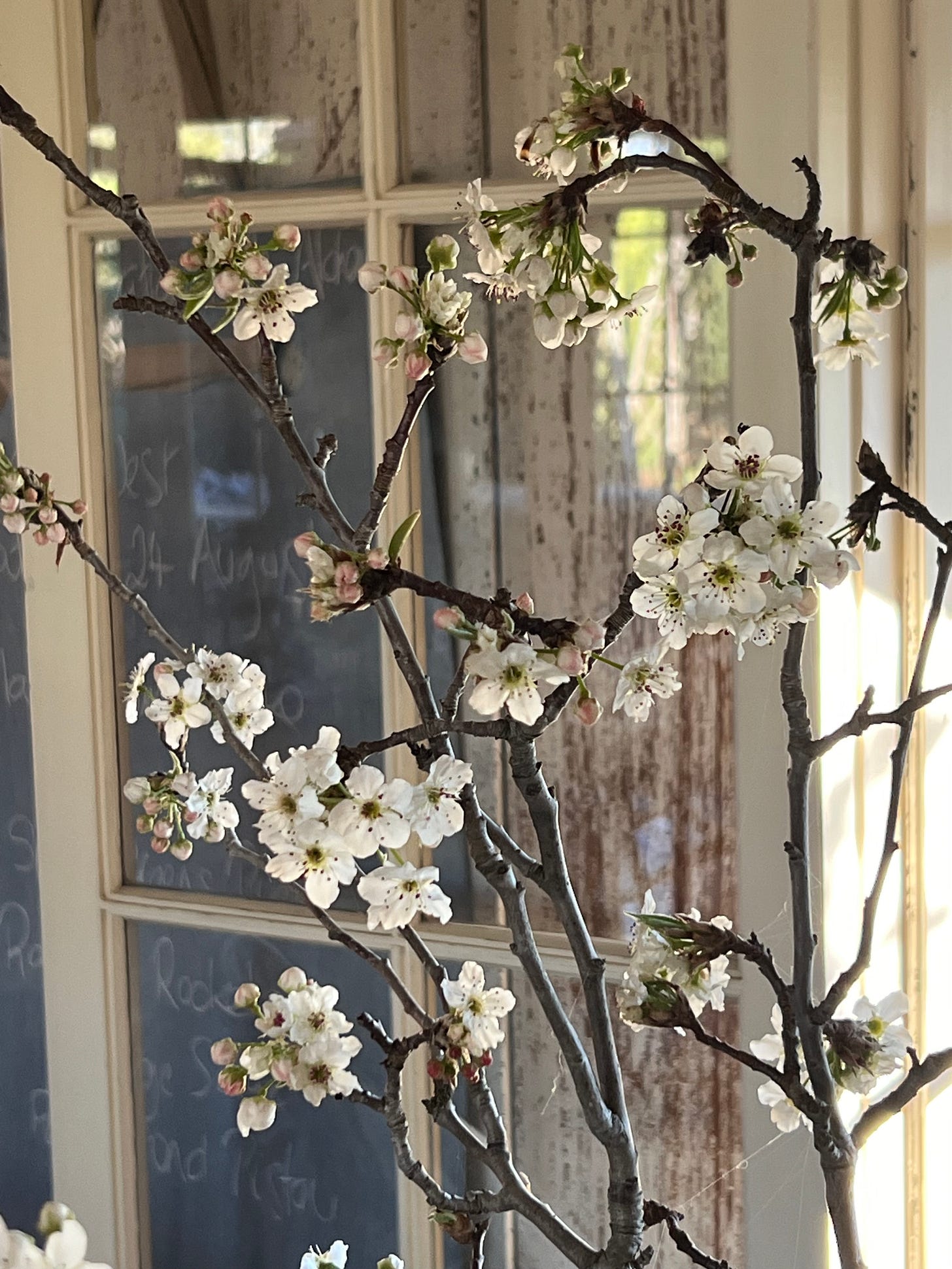
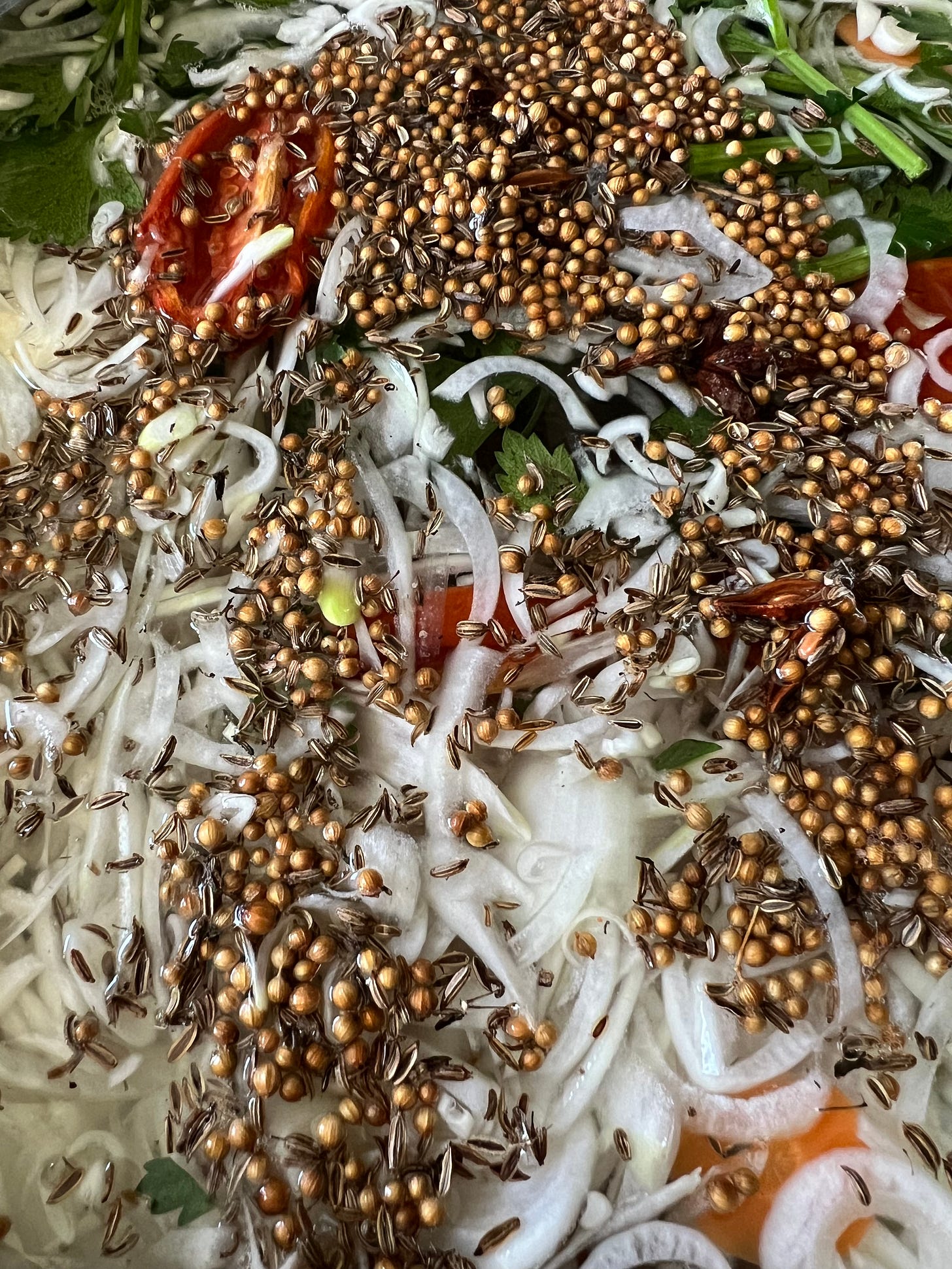

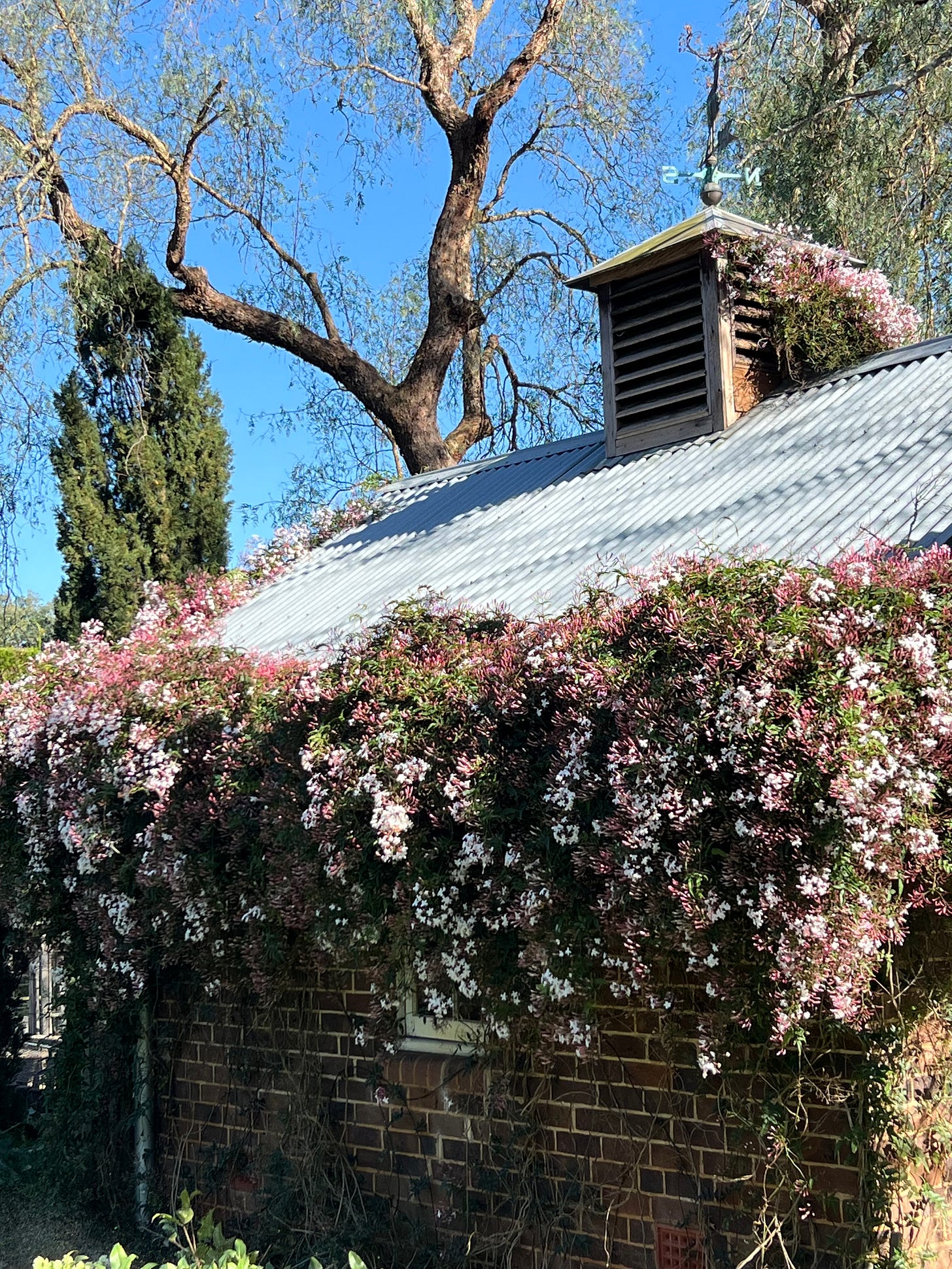



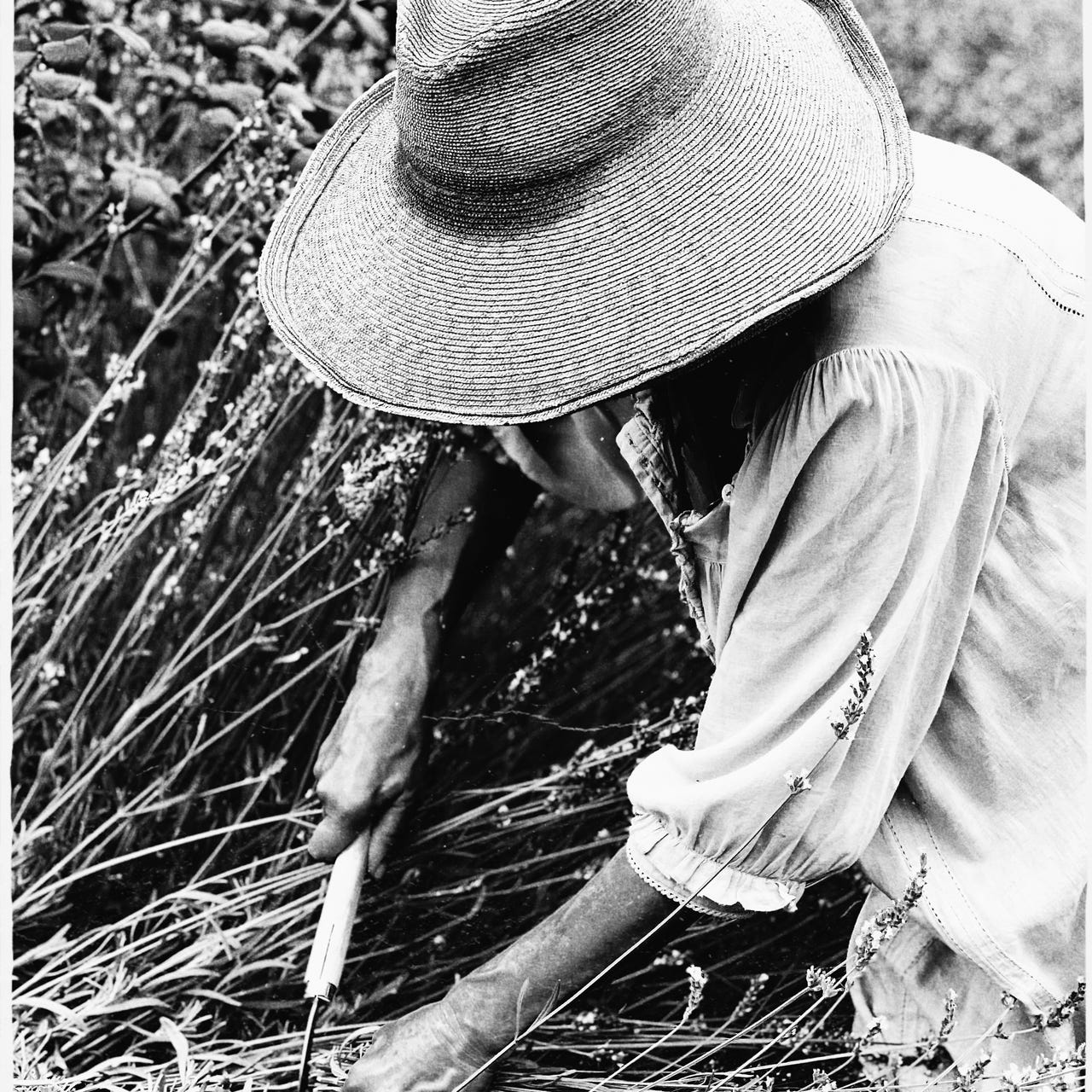
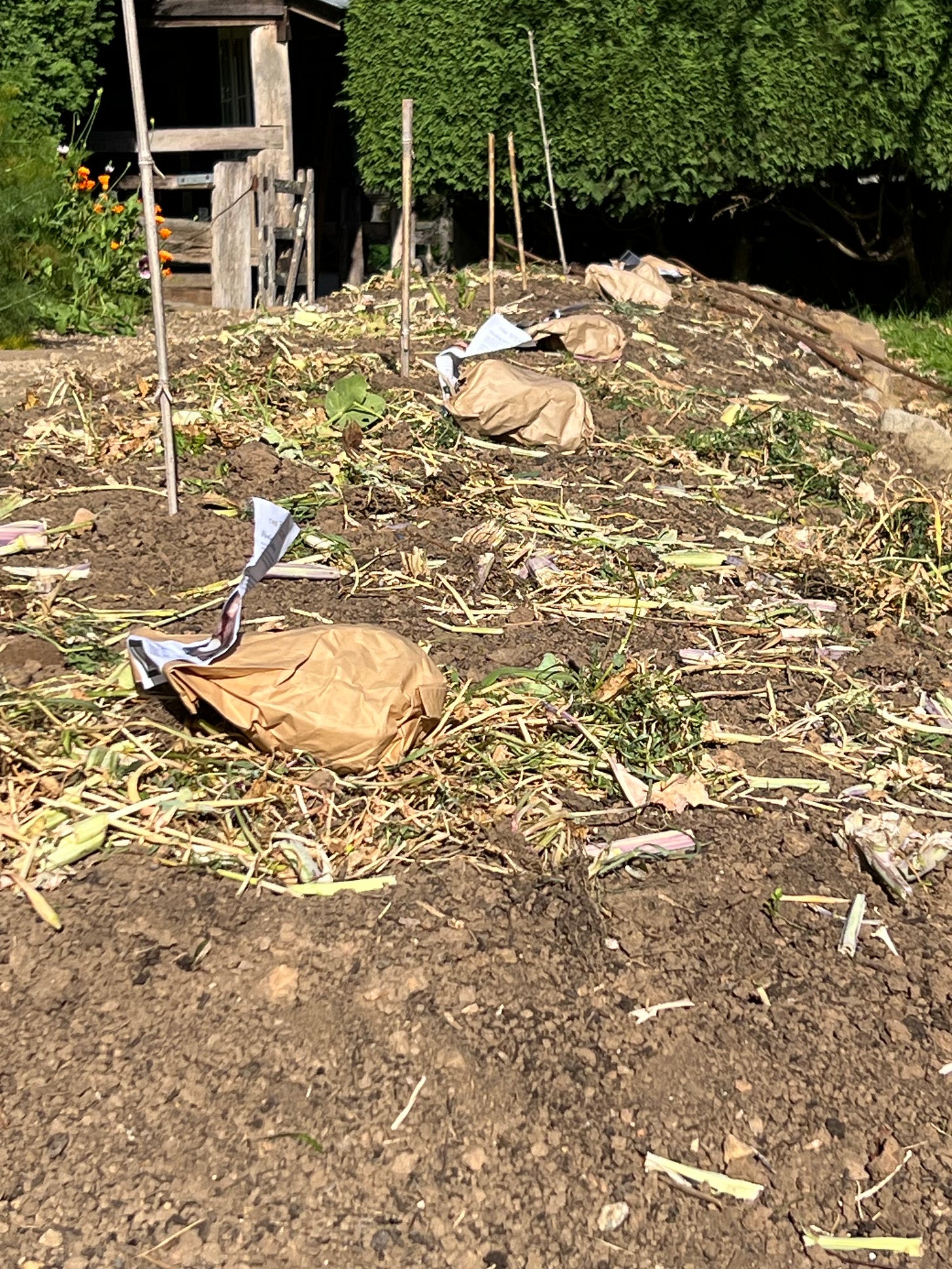

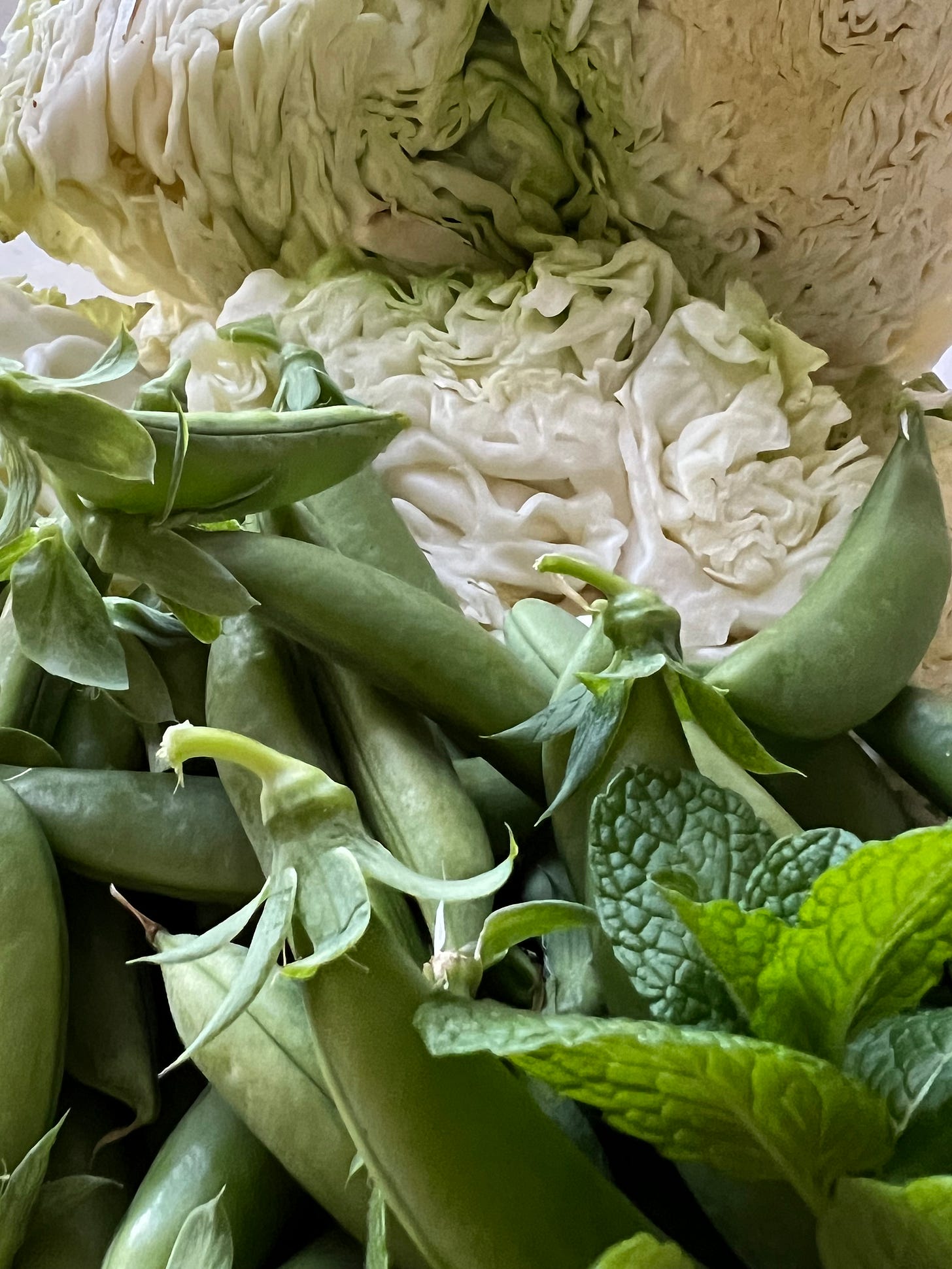
Oh Sally do please get on with sowing those tomato seeds! My seedlings now have true leaves although I'm concerned some of them are too long and leggy and wish they'd fatten up! The roses will be here before we know it! In fact some of my Quatre Saisons are already sending out the odd bloom...I wish they'd hold back! Mx
I'm delighted to hear it! :)))) xx